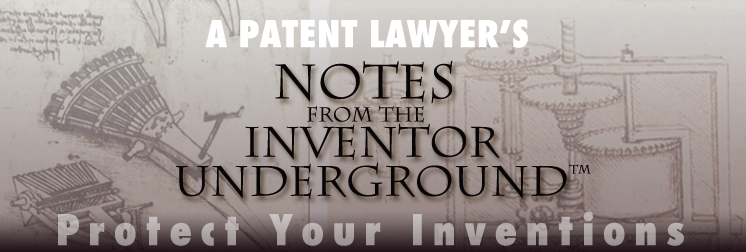Notes from the Inventor Underground

Divorces, Community Property and Intellectual Property — an Overlooked Problem and Some Solutions
Patent and Technology trial lawyer Stan Gibson discusses whether community property laws give divorced spouses rights to an inventor’s patent, and why inventors, owners and purchasers of patents should care.
One important aspect of conducting due diligence for intellectual property acquisitions, valuations or for filing lawsuits is understanding who owns the intellectual property. Often overlooked in this process is the impact of community property laws. The recent case of Enovsys LLC v. Nextel Communications, Inc., et al., 614 F.3d 1333 (Fed. Cir. 2010) provides a wake up call for those conducting due diligence on the ownership of intellectual property.
In Enovsys, the issue was whether a spouse of an inventor had rights–because of community property law–to the inventor’s patent. California law provides that a spouse is entitled to an equal share of community property — that is, property that the spouses create during their marriage. Community property obviously applies to real and personal property, but California’s community property law can also apply to intellectual property that is created during marriage.
This legal principle recently played out in the Enovsys patent infringement case before the Federal Circuit. In Enovsys, a co-inventor (Mr. Fomukong) of two patents (claiming to cover systems for disclosing a mobile device’s location only to authorized requests) filed patent applications while married in California. The couple filed for divorce in 2001 in California. At the time of the filing of the divorce papers, one of the patents had already issued from the Patent and Trade Office (PTO); the other patent issued in 2002, after the divorce was concluded.
After the divorce was concluded, Mr. Fomukong (along with his co-inventor of the two patents) formed Enovsys, to which ownership of the patents was assigned. Enovsys then filed a patent infringement suit against Sprint.
During the case, Sprint moved to dismiss for lack of standing, claiming that Mr. Fumokong’s ex-wife held an interest in the patent because of California law. Prior to making its motion, Sprint had obtained from Mr. Fumokong’s ex-wife any interest that she had in the patent. From Sprint’s standpoint, this would bar Enovsys from enforcing the patent against Sprint as Enovsys would not have standing to enforce the patent and Sprint would have its own rights to the patent.
The district court disagreed. It found the divorce proceedings confirmed that Mr. Fumokong held the interest in the patents because his wife had not listed the patents on the summary dissolution form that the parties used to complete their divorce. After a jury found that Sprint infringed the patents, Sprint appealed.
The Federal Circuit affirmed the district court’s ruling. In determining the issue of patent ownership and standing to sue, the Court analyzed the papers that were filed by Mr. Fumokong and his ex-wife to conclude the divorce. In analyzing these papers, the Federal Circuit noted that the divorce occurred through a summary dissolution in which parties must either affirm that they have no community property or sign a property settlement agreement listing all community assets. The Federal Circuit also noted that Mr. Fomukong and his ex-wife both checked the box on the petition stating they had no community property and no property settlement agreement was attached.
To support its position, Sprint argued that because the divorce decree did not expressly adjudicate community property rights, the ex-wife maintained her ownership interest in the patents. Enovsys argued the opposite position, explaining that the summary dissolution papers demonstrated that Mr. Fumokong’s ex-wife had not claimed a community property interest in the patents. The Federal Circuit agreed with Enovsys and concluded that the presumption that the patents were community property was overcome by the summary dissolution proceeding stating there was no community property. The Court reasoned that the summary dissolution proceeding conferred ownership on Mr. Fumokong and not his ex-wife as a result of the checked box stating that they had no community property. Therefore, Enovsys had ownership and standing to sue.
Although not as notable for the ultimate result that was reached in the case, this case raises many important issues for inventors and for companies acquiring or licensing inventions or other intellectual property. For example, inventors and owners need to consider whether and to what extent their spouse co-owns their inventions or other intellectual property and how that issue may be resolved in a divorce. Employers also need to consider whether they need to have a spouse of an employee sign off on assignment or employment agreements that in any way transfer intellectual property.
Likewise, companies, when acquiring inventions from inventors or when acquiring other intellectual property from employees, will need to take a close look at each of the individuals and understand what if any interest their spouse or former spouse may have depending on the applicable state law. Although Enovsys was ultimately able to confirm ownership and maintain its infringement suit, failure to do appropriate due diligence and understand applicable state law could have fatal consequences. Indeed, it may turn out that the purchased patent cannot be enforced without the cooperation of a third-party ex-spouse, who may be hostile.
To view a representative list of Stan’s patent and technology cases, click here.
 Los Angeles Real Estate Litigation Lawyer Jeffer Mangels Butler & Mitchell LLP Home
Los Angeles Real Estate Litigation Lawyer Jeffer Mangels Butler & Mitchell LLP Home





